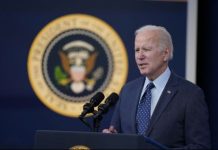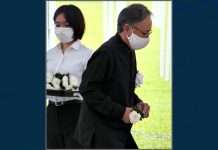
WASHINGTON, Aug. 6 (Danielle Haynes) — The first atomic bomb to be used as a weapon was dropped on Hiroshima, Japan, on Aug. 6, 1945, but Americans wouldn’t know the extent of the devastation for another three weeks when reporters were allowed into the city to survey the scene.
A UPI article from that day says the results of the bomb were still not known, “but military men here said the bomb’s potentialities stagger the imagination.”
Tokyo radio reports also couldn’t put any hard figures on the losses, but said the event had caused so much damage that the atomic bomb “is sufficient to brand the enemy in the ages to come as the destroyer of mankind.” Officials there initially believed the Americans had dropped multiple bombs on the city, thinking the destruction was simply too great to come from a single weapon.
Bodies were so badly burnt and beaten by the heat and collapsing structures that for days Japanese authorities couldn’t even identify the gender of some victims. History would eventually show an estimated 80,000 people died immediately in the blast, a toll that — due to injuries and radiation — rose to about 140,000 by the end of the year.
American journalists filed their first reports from Hiroshima at the end of August, after the second atomic bomb hit Nagasaki on Aug. 7 and after Japan surrendered, ending World War II on Aug. 15. But one correspondent got there first — Leslie Nakashima, who had purely personal reasons to visit Hiroshima on Aug. 22.
Nakashima, who worked on the copy desk at the Japan Times, filed the first personal account of the scene to appear in American newspapers.
He gave the report to a correspondent for UPI, known then as United Press. Nakashima worked for UP’s Tokyo bureau until it closed after the United States entered the war in 1941.
He traveled to Hiroshima not just to get the scoop, though; he wanted to make sure his mother was still alive. Nakashima, his wife and two daughters had left the city just two weeks before the atom bomb dropped. His mother stayed behind.
“As I trod my way through the debris wondering if my mother was still alive, I realized the reality that Hiroshima city had been destroyed through the stupendous destructive power of a single atomic bomb,” he wrote.
Nakashima found his mother’s house — a little more than two miles from the city center — with walls smashed in and the roof shattered. But she was safe.
She had been in a relative’s vegetable field when the bomb hit just after 8 a.m. that day. She saw the flash.
“She immediately threw herself face-down on the ground. She said she heard a terrific explosion and getting up, she saw columns of white smoke rising from all parts of the city high into the sky,” Nakashima wrote.
“She said she then started running to her home as fast as she could because she didn’t know what was coming next. Why she suffered no burns from the ultraviolet rays of the bombs is amazing.”
Earlier in his account, Nakashima described what it was like seeing the destroyed city center for the first time from the train station, which he said “had gone out of existence.”
“There’s not a single building standing intact in the city — until recent of 300,000 population. The death toll is expected to reach 100,000 with people continuing to die daily from burns suffered from the bomb’s ultraviolet rays.”
The only buildings he could see on the skyline were those of a seven-story department store, a five-story newspaper building and a two-story bank. They were mere skeletons.
“There remained no trace whatsoever of private dwellings.”







RUSSIA